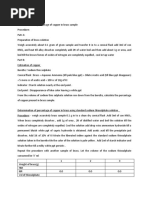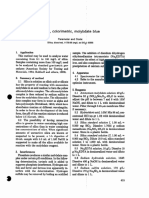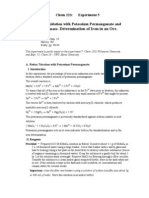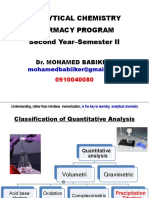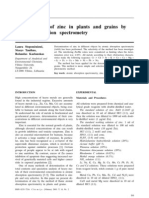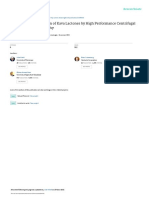DownloadFile 3500 ZN
DownloadFile 3500 ZN
Uploaded by
Penelope MeloCopyright:
Available Formats
DownloadFile 3500 ZN
DownloadFile 3500 ZN
Uploaded by
Penelope MeloOriginal Title
Copyright
Available Formats
Share this document
Did you find this document useful?
Is this content inappropriate?
Copyright:
Available Formats
DownloadFile 3500 ZN
DownloadFile 3500 ZN
Uploaded by
Penelope MeloCopyright:
Available Formats
3-106 METALS (3000)
3500-Zn ZINC*
3500-Zn A. Introduction
1. Occurrence and Significance standard MCL is 5 mg/L. Concentrations above 5 mg/L can
cause a bitter astringent taste and an opalescence in alkaline
Zinc (Zn) is the first element in Group IIB in the periodic waters. Zinc most commonly enters the domestic water supply
table; it has an atomic number of 30, an atomic weight of 65.38, from deterioration of galvanized iron and dezincification of
and a valence of 2. The average abundance of Zn in the earth’s brass. In such cases lead and cadmium also may be present
crust is 76 ppm; in soils it is 25 to 68 ppm; in streams it is 20 because they are impurities of the zinc used in galvanizing. Zinc
g/L, and in groundwaters it is ⬍0.1 mg/L. The solubility of in water also may result from industrial waste pollution.
zinc is controlled in natural waters by adsorption on mineral
surfaces, carbonate equilibrium, and organic complexes. Zinc is 2. Selection of Method
used in a number of alloys such as brass and bronze, and in
batteries, fungicides, and pigments. Zinc is an essential growth The atomic absorption spectrometric methods (3111B and C)
element for plants and animals but at elevated levels it is toxic to and inductively coupled plasma methods (3120 and 3125) are
some species of aquatic life. The United Nations Food and preferred. The zincon method (B), suitable for analysis of both
Agriculture Organization recommended level for zinc in irriga- potable and polluted waters, may be used if instrumentation for
tion waters is 2 mg/L. The U.S. EPA secondary drinking water the preferred methods is not available.
3. Sampling and Storage
* Approved by Standard Methods Committee, 1997.
Joint Task Group: 20th Edition—See 3500-Al. See Section 3010B.2 for sample handling and storage.
3500-Zn B. Zincon Method
1. General Discussion b. Interferences: The following ions interfere at concentra-
tions exceeding those listed:
a. Principle: Zinc forms a blue complex with 2-carboxy-2⬘-
hydroxy-5⬘-sulfoformazyl benzene (zincon) in a solution buff-
Ion mg/L Ion mg/L
ered to pH 9.0. Other heavy metals likewise form colored com-
2⫹ 3⫹
plexes with zincon. Cyanide is added to complex zinc and heavy Cd 1 Cr 10
metals. Cyclohexanone is added to free zinc selectively from its Al3⫹ 5 Ni2⫹ 20
cyanide complex so that it can be complexed with zincon to form Mn2⫹ 5 Cu2⫹ 30
Fe3⫹ 7 Co2⫹ 30
a blue color. Sodium ascorbate reduces manganese interference.
Fe2⫹ 9 CrO42⫺ 50
The developed color is stable except in the presence of copper
(see table below).
c. Minimum detectable concentration: 0.02 mg Zn/L.
ZINC (3500-Zn)/Zincon Method 3-107
2. Apparatus ascorbate, 5.0 mL buffer solution, 2.0 mL KCN solution, and 3.0
mL zincon solution. Pipet 20.0 mL of the solution into a clean
a. Colorimetric equipment: One of the following is required: 50-mL erlenmeyer flask. Reserve remaining solution to zero the
1) Spectrophotometer, for measurements at 620 nm, provid- instrument. Add 1.0 mL cyclohexanone to the erlenmeyer flask.
ing a light path of 1 cm or longer. Swirl for 10 s and note time. Transfer portions of both solutions
2) Filter photometer, providing a light path of 1 cm or longer to clean sample cells. Use solution without cyclohexanone to
and equipped with a red filter having maximum transmittance zero colorimeter. Read and record absorbance for solution with
near 620 nm. Deviation from Beer’s Law occurs when the filter cyclohexanone after 1 min. The calibration curve does not pass
band pass exceeds 20 nm. through zero because of the color enhancement effect of cyclo-
b. Graduated cylinders, 50-mL, with ground-glass stoppers, hexanone on zincon.
Class B or better. b. Treatment of samples: To determine readily acid-extract-
c. Erlenmeyer flasks, 50-mL. able total zinc, add 1 mL conc HCl to 50 mL sample and mix
d. Filtration apparatus: 0.45-m filters and filter holders. thoroughly. Filter and adjust to pH 7. To determine dissolved
zinc, filter sample through a 0.45-m membrane filter. Adjust to
3. Reagents pH 7 with 1N NaOH or 1N HCl if necessary after filtering.
c. Sample analysis: Cool samples to less than 30°C if neces-
a. Metal-free water: See Section 3111B.3c. Use water for sary. Analyze 20.0 mL of prepared sample as described in ¶ 4a
rinsing apparatus and preparing solutions and dilutions. above, beginning with “Add the following to each solution . . .”
b. Stock zinc solution: Dissolve 1000 mg (1.000 g) zinc metal If the zinc concentration exceeds 7 mg Zn/L prepare a sample
in 10 mL 1 ⫹ 1 HNO3. Dilute and boil to expel oxides of dilution and analyze a 20.0-mL portion.
nitrogen. Dilute to 1000 mL; 1.00 mL ⫽ 1.00 mg Zn.
c. Standard zinc solution: Dilute 10.00 mL stock zinc solution 5. Calculation
to 1000 mL; 1.00 mL ⫽ 10.00 g Zn.
d. Sodium ascorbate, fine granular powder, USP. Read zinc concentration (in milligrams per liter) directly from
e. Potassium cyanide solution: Dissolve 1.00 g KCN in ap- the calibration curve.
proximately 50 mL water and dilute to 100 mL. CAUTION:
Potassium cyanide is a deadly poison. Avoid skin contact or 6. Precision and Bias
inhalation of vapors. Do not pipet by mouth or bring in contact
with acids. A synthetic sample containing 650 g Zn/L, 500 g Al/L, 50
f. Buffer solution, pH 9.0: Dissolve 8.4 g NaOH pellets in g Cd/L, 110 g Cr/L, 470 g Cu/L, 300 g Fe/L, 70 g Pb/L,
about 500 mL water. Add 31.0 g H3BO3 and swirl or stir to 120 g Mn/L, and 150 g Ag/L in doubly demineralized water
dissolve. Dilute to 1000 mL with water and mix thoroughly. was analyzed in a single laboratory. A series of 10 replicates
g. Zincon reagent: Dissolve 100 mg zincon (2-carboxy-2⬘- gave a relative standard deviation of 0.96% and a relative error
hydroxy-5⬘-sulfoformazyl benzene) in 100 mL methanol. Be- of 0.15%. A wastewater sample from an industry in Standard
cause zincon dissolves slowly, stir and/or let stand overnight. Industrial Classification (SIC) No. 3333, primary smelting and
h. Cyclohexanone, purified. refining of zinc, was analyzed by 10 different persons. The mean
i. Hydrochloric acid, HCl, conc and 1N. zinc concentration was 3.36 mg Zn/L and the relative standard
j. Sodium hydroxide, NaOH, 6N and 1N. deviation was 1.7%. The relative error compared to results from
an atomic absorption analysis of the same sample was ⫺1.0%.
4. Procedure
7. Bibliography
a. Preparation of colorimetric standards: Accurately deliver
0, 0.5, 1.0, 3.0, 5.0, 10.0, and 14.0 mL standard zinc solution to PLATTE, J.A. & V.M. MARCY. 1959. Photometric determination of zinc
a series of 50-mL graduated mixing cylinders. Dilute each to with zincon. Anal. Chem. 31:1226.
RUSH, R.M. & J.H. YOE. 1954. Colorimetric determination of zinc and
20.0 mL to yield solutions containing 0, 0.25, 0.5, 1.5, 2.5, 5.0,
copper with 2-carboxy-2⬘-hydroxy-5⬘-sulfoformazyl-benzene.
and 7.0 mg Zn/L, respectively. (Lower-range standards may be Anal. Chem. 26:1345.
prepared to extend the quantitation range. Longer optical path MILLER, D.G. 1979. Colorimetric determination of zinc with zincon and
cells can be used. Verify linearity of response in this lower cyclohexanone. J. Water Pollut. Control Fed. 51:2402.
concentration range.) Add the following to each solution in PANDE, S.P. 1980. Study on the determination of zinc in drinking water.
sequence, mixing thoroughly after each addition: 0.5 g sodium J. IWWA XII (3):275.
You might also like
- Zinc Titration Xylenol OrangeDocument6 pagesZinc Titration Xylenol OrangeDimitri JourdanNo ratings yet
- CMM 26 20 29 Rev 6 Dated Jan 2019Document32 pagesCMM 26 20 29 Rev 6 Dated Jan 2019TESTNo ratings yet
- 4500-Cl BDocument4 pages4500-Cl Bbudi_alamsyahNo ratings yet
- DownloadFile 3500 ZNDocument2 pagesDownloadFile 3500 ZNpollux23No ratings yet
- 3500 PBDocument3 pages3500 PBpollux23No ratings yet
- Bt20civ007 Ee Lab FileDocument12 pagesBt20civ007 Ee Lab FileShivang KumarNo ratings yet
- Lab Report Environmental Engineering 2 (CEL304)Document40 pagesLab Report Environmental Engineering 2 (CEL304)Shivang KumarNo ratings yet
- Methods Based On The Absorption of RadiationDocument5 pagesMethods Based On The Absorption of RadiationEdna Lip AnerNo ratings yet
- SM+3500+Mn 20th+edDocument3 pagesSM+3500+Mn 20th+edNguyen KieuNo ratings yet
- 3500-Mn Manganese (Editorial Revisions, 2011)Document3 pages3500-Mn Manganese (Editorial Revisions, 2011)Gustavo Baccho Jorge FilhoNo ratings yet
- Persulfate MethodDocument6 pagesPersulfate MethodvactlabNo ratings yet
- Application of Ion Exchange ResinDocument3 pagesApplication of Ion Exchange ResinEdna Lip AnerNo ratings yet
- Determination of Percentage of Copper in Brass SampleDocument7 pagesDetermination of Percentage of Copper in Brass SampleSayeeda Anjum0% (1)
- Cyanide Method Picric Acid 1Document3 pagesCyanide Method Picric Acid 1Ferudun AkyolNo ratings yet
- Amidon de BleDocument2 pagesAmidon de Blejeanluc hayenNo ratings yet
- Expt 1 Chem 1 .Document45 pagesExpt 1 Chem 1 .Farhatul Abrar AnandaNo ratings yet
- Silica, Calorimetric, Molybd'ate Blue: 1. ApplicationDocument2 pagesSilica, Calorimetric, Molybd'ate Blue: 1. ApplicationLượng Nguyễn VănNo ratings yet
- Potentiometric Determination of Cyanide 692960 - AB-046 - 2 - ENDocument7 pagesPotentiometric Determination of Cyanide 692960 - AB-046 - 2 - ENMaximino AlvarezNo ratings yet
- 4500 So3 SulfitoDocument4 pages4500 So3 SulfitoCecilia AvilaNo ratings yet
- SM 4500 CL ChlorineDocument7 pagesSM 4500 CL ChlorineRonald Figo Torres EcheNo ratings yet
- CHM 421 Analytical Chemistry Experiment 6: Analysis of Bleach and Copper (Ii) UnknownDocument14 pagesCHM 421 Analytical Chemistry Experiment 6: Analysis of Bleach and Copper (Ii) UnknownIntan SapuraNo ratings yet
- Experiment: Aim: Estimation of COD in Water Sample PrincipleDocument2 pagesExperiment: Aim: Estimation of COD in Water Sample Principlenidhi varshneyNo ratings yet
- Atomic SpectrosDocument4 pagesAtomic SpectrosEdna Lip AnerNo ratings yet
- 3500-Ca Calcium : 1. Occurrence and SignificanceDocument2 pages3500-Ca Calcium : 1. Occurrence and SignificanceAndrés Osorio100% (1)
- Iron Content in FoodsDocument5 pagesIron Content in FoodsPatrick Quiroz MorenoNo ratings yet
- Zinc CarbonateDocument2 pagesZinc CarbonateKasidit SornchaiNo ratings yet
- Chem 28.2Document38 pagesChem 28.2Nestor NemeñoNo ratings yet
- Zinc, Method 8009, 02-2009, 9th EdDocument6 pagesZinc, Method 8009, 02-2009, 9th EdJe RivasNo ratings yet
- 5 - Lab5 - Permanganate and Dichromate TitrationDocument5 pages5 - Lab5 - Permanganate and Dichromate TitrationHoang Thao0% (1)
- Analytical Chem - Post Lab NotesDocument11 pagesAnalytical Chem - Post Lab NotesMare5Der5No ratings yet
- DownloadFile 3500 KDocument3 pagesDownloadFile 3500 Kpollux23No ratings yet
- SulfatosDocument7 pagesSulfatosJohan andres Morales carvajalNo ratings yet
- Lab ManualDocument31 pagesLab ManualMadhurjya DekaNo ratings yet
- Lecture 6. Precipitation TitrationDocument21 pagesLecture 6. Precipitation TitrationMohamed Babiker SulimanNo ratings yet
- 4500 O3 ResidualDocument3 pages4500 O3 ResidualPenelope MeloNo ratings yet
- EPA 130.2 DUREZA Title Hardness Total MG L As CacoDocument5 pagesEPA 130.2 DUREZA Title Hardness Total MG L As Cacolic.godoymariaNo ratings yet
- Complexing Capacity of Salicylaldoxime With Nickel and Zinc by Differential Pulse PolarographyDocument3 pagesComplexing Capacity of Salicylaldoxime With Nickel and Zinc by Differential Pulse PolarographyInternational Journal of Innovative Science and Research TechnologyNo ratings yet
- CH425Document35 pagesCH425Vatra ReksaNo ratings yet
- Applications of Redox ReactionsDocument50 pagesApplications of Redox ReactionsMlamuli MlarhNo ratings yet
- Standard Methods For The Examination of Water and WastewaterDocument4 pagesStandard Methods For The Examination of Water and WastewaterMarianita GonzalezNo ratings yet
- 3500-Al Rev Edit 2011Document4 pages3500-Al Rev Edit 2011ImmerNo ratings yet
- Volumetric Determination of Nickel in SteelDocument2 pagesVolumetric Determination of Nickel in SteelivanNo ratings yet
- Chem Exp2 20BEC0388Document3 pagesChem Exp2 20BEC0388TTGNo ratings yet
- SM 3500 AlDocument4 pagesSM 3500 AlNARET85No ratings yet
- 8 - Monographie Amidon de Mais - Corn StarchDocument3 pages8 - Monographie Amidon de Mais - Corn Starchasmae.labindusNo ratings yet
- American Society of Limnology and OceanographyDocument6 pagesAmerican Society of Limnology and OceanographyDominique LefevreNo ratings yet
- Zinc in PlanteDocument4 pagesZinc in PlanteDaniela MarinescuNo ratings yet
- Palatte, Photometric DeterminationDocument3 pagesPalatte, Photometric DeterminationJe RivasNo ratings yet
- Approval Sheet: Mutmainnah Umar Rahmatia ID. 1513440003 ID. 1613040013Document15 pagesApproval Sheet: Mutmainnah Umar Rahmatia ID. 1513440003 ID. 1613040013rulmadhaniNo ratings yet
- Expts For Chem EnggDocument37 pagesExpts For Chem Enggblackbeauty1450% (2)
- Ion Exchange ChromatographyDocument2 pagesIon Exchange ChromatographyGovardhan BalajiNo ratings yet
- 08 - To Determine The Solubility Product Constant of A Sparingly Soluble SaltDocument2 pages08 - To Determine The Solubility Product Constant of A Sparingly Soluble SaltAisha PetersNo ratings yet
- Cyanide Titration With Silver NitrateDocument5 pagesCyanide Titration With Silver Nitratetito cuadros100% (2)
- UV-VIS Spectroscopy LabDocument5 pagesUV-VIS Spectroscopy Lablee (nyto)No ratings yet
- Experiment 1 Preparation and Standardization of Volumetric SolutionsDocument28 pagesExperiment 1 Preparation and Standardization of Volumetric SolutionsMylene Mendoza0% (2)
- Analytical Separation by Ion-Exchange Chromatography - Lab ReportDocument5 pagesAnalytical Separation by Ion-Exchange Chromatography - Lab ReportVu SonNo ratings yet
- Complex SaltDocument8 pagesComplex Saltmipa amarNo ratings yet
- 3500-As ArsenicDocument3 pages3500-As ArsenicDavid AmayaNo ratings yet
- Electrogravimetric MethodsDocument3 pagesElectrogravimetric MethodsEdna Lip AnerNo ratings yet
- Advanced Pharmaceutical analysisFrom EverandAdvanced Pharmaceutical analysisRating: 4.5 out of 5 stars4.5/5 (2)
- The Chemistry of Fertilisers and Manure - Including Information on the Chemical Constituents and Types of Fertilisers and ManuresFrom EverandThe Chemistry of Fertilisers and Manure - Including Information on the Chemical Constituents and Types of Fertilisers and ManuresRating: 5 out of 5 stars5/5 (1)
- Implementing of Good Laboratory Practice (GLP) in Food Analysis Laboratories of Baghdad UniversityDocument5 pagesImplementing of Good Laboratory Practice (GLP) in Food Analysis Laboratories of Baghdad UniversityPenelope MeloNo ratings yet
- InstagramHacks Guide enDocument9 pagesInstagramHacks Guide enPenelope MeloNo ratings yet
- ++CFA Micro Testing Interpretation 2nd EdDocument27 pages++CFA Micro Testing Interpretation 2nd EdPenelope MeloNo ratings yet
- Lab 9: Standard Plate Count: How Do We Know How Many Bacteria Are in A Liquid?Document4 pagesLab 9: Standard Plate Count: How Do We Know How Many Bacteria Are in A Liquid?Penelope MeloNo ratings yet
- Chapter Overview: 35: The Nervous SystemDocument1 pageChapter Overview: 35: The Nervous SystemPenelope MeloNo ratings yet
- DownloadFile 3500 UDocument1 pageDownloadFile 3500 UPenelope MeloNo ratings yet
- DownloadFile 3500HgDocument1 pageDownloadFile 3500HgPenelope MeloNo ratings yet
- 3500 GaDocument1 page3500 GaPenelope MeloNo ratings yet
- DownloadFile 3500 SeDocument8 pagesDownloadFile 3500 SePenelope MeloNo ratings yet
- 2320 Alkalinity : 1. DiscussionDocument3 pages2320 Alkalinity : 1. DiscussionPenelope MeloNo ratings yet
- 1080 Reagent WaterDocument3 pages1080 Reagent WaterPenelope MeloNo ratings yet
- 4500-Sio Silica : 4-164 Inorganic Nonmetals (4000)Document7 pages4500-Sio Silica : 4-164 Inorganic Nonmetals (4000)Penelope Melo100% (1)
- DownloadFile 3500 LiDocument2 pagesDownloadFile 3500 LiPenelope Melo100% (1)
- 2324 Level M (Gr11 UAE-Gulf) Chemistry Topics Course Question Document SolutionDocument64 pages2324 Level M (Gr11 UAE-Gulf) Chemistry Topics Course Question Document Solutionalaamoalla02No ratings yet
- PUR 03 LIST of Approved Supplier - 2023Document6 pagesPUR 03 LIST of Approved Supplier - 2023nbr.qualitygbNo ratings yet
- Assignment 2Document2 pagesAssignment 2Ryan CarrollNo ratings yet
- Department of EducationDocument3 pagesDepartment of EducationMaribel membradoNo ratings yet
- Astm F436 F436M 19Document4 pagesAstm F436 F436M 19Kalanithi GKNo ratings yet
- Chemistry For Engineers - Lecture Answer Sheet For Activities and AssessmentDocument8 pagesChemistry For Engineers - Lecture Answer Sheet For Activities and AssessmentSelario, Prince Carl M.No ratings yet
- (Liquid Crystals Book Series) Peter J. Collings, Michael Hird-Introduction To Liquid Crystals - Chemistry and Physics-CRC Press (1997)Document317 pages(Liquid Crystals Book Series) Peter J. Collings, Michael Hird-Introduction To Liquid Crystals - Chemistry and Physics-CRC Press (1997)ADITYA AGRAWALNo ratings yet
- Study On Thermal Management of Rectangular Li Ion Battery WithDocument10 pagesStudy On Thermal Management of Rectangular Li Ion Battery WithGraziela Barbosa Brito da PaixãoNo ratings yet
- Boysen Latex Color Lampblack B-1490Document6 pagesBoysen Latex Color Lampblack B-1490cathleencatedelacruzNo ratings yet
- Alcohols and PhenolsDocument9 pagesAlcohols and Phenolsdivya divyaNo ratings yet
- CH-5 Migration of HydrocarbonsDocument48 pagesCH-5 Migration of HydrocarbonsHamza AkhtarNo ratings yet
- Journal of Environmental Chemical EngineeringDocument9 pagesJournal of Environmental Chemical Engineeringherdi sutanto adigunaNo ratings yet
- JEE Advanced 2018 Paper - 1 Question With Solution - ChemistryDocument13 pagesJEE Advanced 2018 Paper - 1 Question With Solution - ChemistrySanju PatelNo ratings yet
- Isolation and Purification of Kava Lactones by High Performance Centrifugal Partition ChromatographyDocument8 pagesIsolation and Purification of Kava Lactones by High Performance Centrifugal Partition ChromatographyMenoddin shaikhNo ratings yet
- MIS Template EditingDocument31 pagesMIS Template Editingesmaadrian18No ratings yet
- Lec 8aDocument23 pagesLec 8adavidolalere7No ratings yet
- Dokumen - Tips - Gpsa 13 Ed Separation PDFDocument48 pagesDokumen - Tips - Gpsa 13 Ed Separation PDFNovi WulansariNo ratings yet
- Chapter 2 NotesDocument76 pagesChapter 2 NotesJosch DenilaNo ratings yet
- 8.T-MEET315 Fundamentals MatScie Engg Module 8Document26 pages8.T-MEET315 Fundamentals MatScie Engg Module 8Cj TilamNo ratings yet
- TMAH 25 Tetramethylammonium HydroxideDocument4 pagesTMAH 25 Tetramethylammonium HydroxideCheNo ratings yet
- Bio PracticalDocument66 pagesBio Practicalliow junhaoNo ratings yet
- Influence of Deteriorated Solvent On Induction Period of Grignard Reagent FormationDocument7 pagesInfluence of Deteriorated Solvent On Induction Period of Grignard Reagent Formationmanuel querolNo ratings yet
- المستند defects condensed miDocument6 pagesالمستند defects condensed miKhadiga GadNo ratings yet
- Wall Footing: Code ReferencesDocument4 pagesWall Footing: Code ReferencesSupun Aravinda JayawardhaneNo ratings yet
- MYP Final Timetable - May 2024Document8 pagesMYP Final Timetable - May 2024Vinisha KhuranaNo ratings yet
- Green Chemistry LogoDocument1 pageGreen Chemistry LogoAbhishekmalviyaNo ratings yet
- Gas TestingDocument51 pagesGas Testingfauziot100% (1)
- Kraton Masterbatches Paper Presented at International Latex Conference 2015Document17 pagesKraton Masterbatches Paper Presented at International Latex Conference 2015Thamirys LunaNo ratings yet
- Detailed Kinetic Modeling of NH and H O Adsorption, and NH Oxidation Over Cu-ZSM-5Document13 pagesDetailed Kinetic Modeling of NH and H O Adsorption, and NH Oxidation Over Cu-ZSM-5Tarık Bercan SarıNo ratings yet












